Getting Started with ASP.NET MVC ReportViewer
8 Jun 202111 minutes to read
This section explains briefly about how to create a ReportViewer in your web application with MVC.
Create your first ReportViewer in MVC
This section explains how to configure a ReportViewer component in web application. As ReportViewer uses WebApi to process the report file, you can also learn how to create WebApi Service to process the report for ReportViewer. In the following example, the ReportViewer component displays the Sales Dashboard Report.
Open Visual Studio and create a new project by clicking New Project. Select the Web category, select the ASP.NET MVC4 Web Application template, and then click OK. The following screenshot displays the Project Creation Wizard.
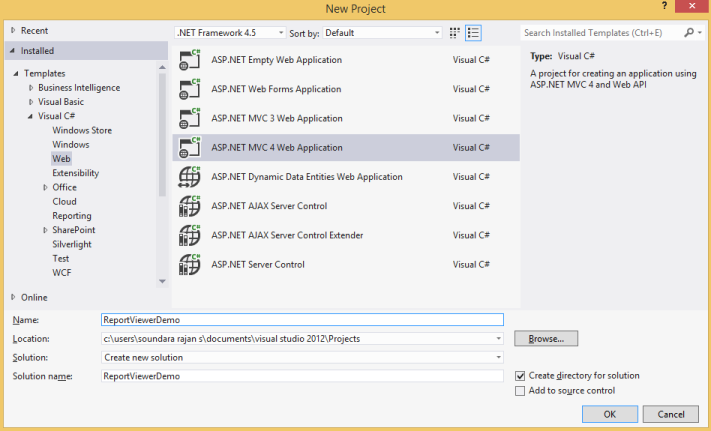
Project Creation Wizard
The following screenshot displays how to select Internet application template with razor view engine.
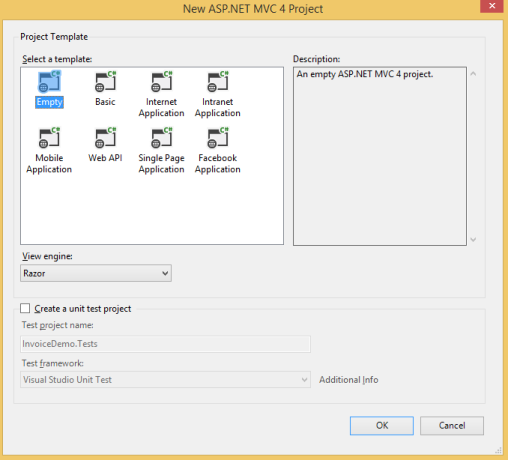
Add References, Scripts, Styles and Control in CSHTML Page
Add References
-
In the Solution Explorer, right-click the References folder and then click Add Reference
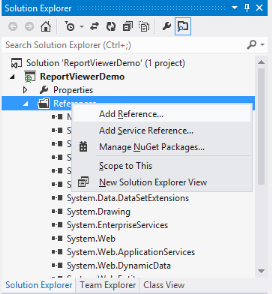
Adding Reference
-
Add the following assemblies
- System.Web.Routing
- System.Web.Http
- System.Web.WebHost
- System.Net.Http
- System.Net.Http.WebRequest
- System.Net.Http.Formatting
- Syncfusion.Linq.Base
- Syncfusion.EJ
- Syncfusion.EJ.MVC
- Syncfusion.EJ.ReportViewer
- Syncfusion.Pdf.Base
- Syncfusion.XlsIO.Base
- Syncfusion.DocIO.Base
- Syncfusion.Shared.Wpf
- Syncfusion.Chart.Wpf
- Syncfusion.Gauge.Wpf
- Syncfusion.SfMaps.Wpf
NOTE
Refer the above assemblies from the installed location, C:\Program Files (x86)\Syncfusion\Essential Studio\ASP.NET MVC\32.1.19\Assemblies
Refer System.Web.Http, System.Web.WebHost, System.Net.Http.WebRequest and System.Net.Http.Formatting assemblies from ASP.NET WebApi NuGet package.
-
Click OK
Add Scripts and Styles
Add the script files and CSS files in the <title> tag of the _Layout.cshtml page.
NOTE
Use the following code example while adding scripts and styles.
<link rel="stylesheet" href="https://cdn.syncfusion.com/32.1.19/js/web/flat-azure/ej.web.all.min.css" />
<script src="https://code.jquery.com/jquery-1.10.2.min.js" type="text/javascript"></script>
<script src="https://cdnjs.cloudflare.com/ajax/libs/jquery-easing/1.3/jquery.easing.min.js" type="text/javascript"></script>
<script src="https://cdn.syncfusion.com/32.1.19/js/web/ej.web.all.min.js"> </script>
<script src="https://cdn.syncfusion.com/32.1.19/js/common/ej.unobtrusive.min.js"></script>Add Control in View page
Add the following code example in the Index.cshtml page that is already created. Set the desired ReportPath and ReportServiceUrl to ReportViewer.
@using Syncfusion.MVC.EJ
@using Syncfusion.JavaScript.Models
@using Syncfusion.JavaScript
@using Syncfusion.JavaScript.ReportViewer
@{
ViewBag.Title = "Index";
}
<h2>Index</h2>
<div>
@{Html.EJ().ReportViewer("viewer").ReportPath("~/App_Data/Sales Dashboard.rdl").ReportServiceUrl("/api/ReportApi").Render();}
</div>NOTE
Add your report files to your application’s App_Data folder. You can obtain sample rdl/rdlc files from Syncfusion installed location(%userprofile%\AppData\Local\Syncfusion\EssentialStudio\32.1.19\Common\Data\ejReportTemplate). 32.1.19 is the Essential Studio Release Version.
Add WebAPI controller for ReportViewer
The MVC ReportViewer uses WebApi services to process the report file and process the request from control.
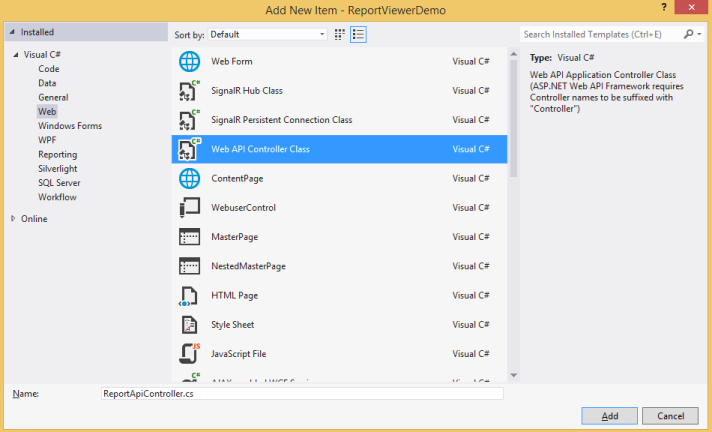
Adding WebApi Controller
Inherit IReportController
The ApiController inherits the IReportController and you can add the following code example to its methods definition in order to process the report file. The interface IReportController contains the required actions and helper methods declaration to process the report. The ReportHelper class contains helper methods that helps to process Post/Get request from control and return the response to control.
using Syncfusion.EJ.ReportViewer;
using System;
using System.Collections.Generic;
using System.Linq;
using System.Net;
using System.Net.Http;
using System.Web.Http;
namespace ReportViewerDemo.Api
{
public class ReportApiController : ApiController, IReportController
{
//Post action for processing the rdl/rdlc report
public object PostReportAction(Dictionary<string, object> jsonResult)
{
return ReportHelper.ProcessReport(jsonResult, this);
}
//Get action for getting resources from the report
[System.Web.Http.ActionName("GetResource")]
[AcceptVerbs("GET")]
public object GetResource(string key, string resourcetype, bool isPrint)
{
return ReportHelper.GetResource(key, resourcetype, isPrint);
}
//Method will be called when initialize the report options before start processing the report
public void OnInitReportOptions(ReportViewerOptions reportOption)
{
//You can update report options here
}
//Method will be called when reported is loaded
public void OnReportLoaded(ReportViewerOptions reportOption)
{
//You can update report options here
}
}
}WebAPI Routing
You can route the WebAPI in Application_Start event into Global.asax file as follows.
using System;
using System.Collections.Generic;
using System.Linq;
using System.Web;
using System.Web.Security;
using System.Web.SessionState;
using System.Web.Http;
namespace ReportViewerDemo
{
public class Global : System.Web.HttpApplication
{
protected void Application_Start(object sender, EventArgs e)
{
System.Web.Http.GlobalConfiguration.Configuration.Routes.MapHttpRoute(
name: "DefaultApi",
routeTemplate: "api/{controller}/{action}/{id}",
defaults: new { id = RouteParameter.Optional });
}
}
}Run the Application
Run the sample application and you can see the ReportViewer on the page as displayed in the following screenshot.
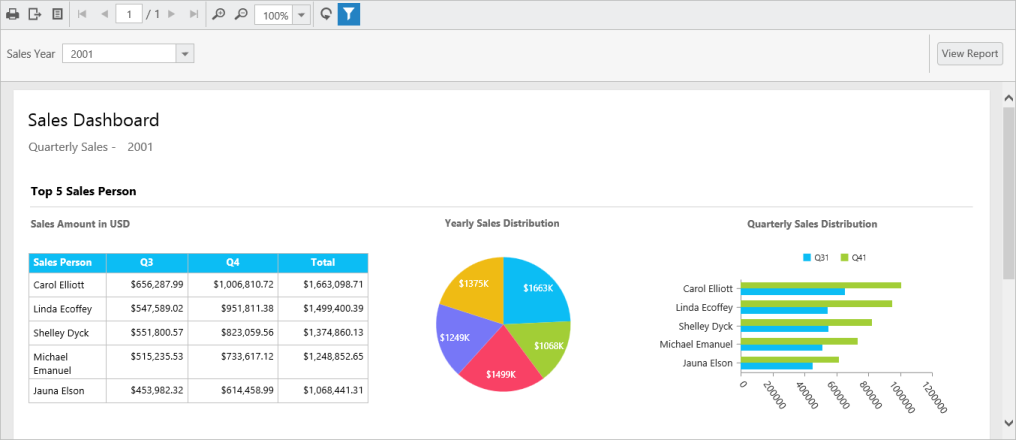
ReportViewer with Sales Dashboard Report
Load SSRS Server Reports
ReportViewer supports to load RDL/RDLC files from SSRS Server. The following steps help you to load reports from SSRS Server.
-
Set the ReportPath from SSRS and SSRS ReportServerUrl in the ReportViewer properties.
@using Syncfusion.MVC.EJ @using Syncfusion.JavaScript.Models @using Syncfusion.JavaScript @using Syncfusion.JavaScript.ReportViewer @{ ViewBag.Title = "Index"; } <h2>Index</h2> <div> @(Html.EJ().ReportViewer("viewer").ProcessingMode(Syncfusion.JavaScript.ReportViewerEnums.ProcessingMode.Remote) .ReportServiceUrl("/api/ReportApi") .ReportServerUrl("http://mvc.syncfusion.com/reportserver") .ReportPath("/SSRSSamples2/Territory Sales new")) </div> -
Add the credential information in ReportApiController’sOnInitReportOptions method that is inherited in IReportController.
public void OnInitReportOptions(ReportViewerOptions reportOption) { //Add SSRS Server and database credentials here reportOption.ReportModel.ReportServerCredential = new System.Net.NetworkCredential("ssrs", "RDLReport1"); reportOption.ReportModel.DataSourceCredentials.Add(new DataSourceCredentials("AdventureWorks", "ssrs1", "RDLReport1")); } -
Run the application and you can see the ReportViewer on the page as displayed in the following screenshot.
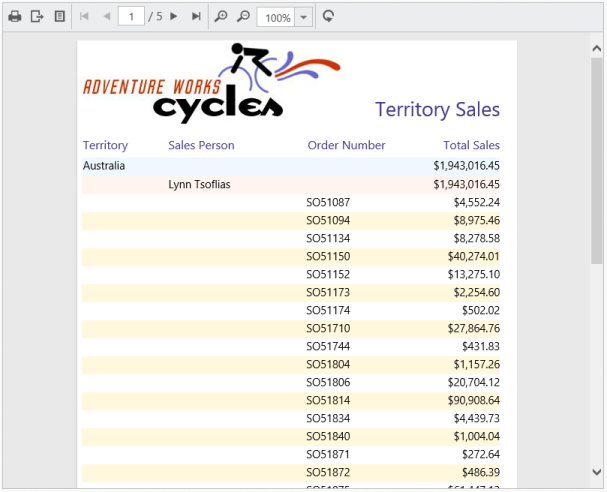
Report from SSRS
Load RDLC Reports
The ReportViewer has data binding support to visualize the RDLC reports. The following code example helps you to bind data to ReportViewer.
-
Assign the RDLC report path to ReportViewer’sReportPath property and set the data sources to the ReportViewer’sDataSources property.
@(Html.EJ().ReportViewer("viewer").ProcessingMode(Syncfusion.JavaScript.ReportViewerEnums.ProcessingMode.Local) .ReportPath("~/App_Data/Product List.rdlc") .ReportServiceUrl("/api/ReportApi") .DataSources(ds => ds.Name("list").Value(ViewData["reportDsource"]).Add())) -
The following code example illustrates the creation of business object data source.
namespace ReportViewerDemo.Controllers { public partial class ReportViewerController : Controller { public ActionResult ProductList() { ProductList prodlist = new ProductList(); ViewData["reportDsource"] = prodlist.GetData(); return View(); } } public class ProductList { public string ProductName { get; set; } public string OrderId { get; set; } public double Price { get; set; } public string Category { get; set; } public string Ingredients { get; set; } public string ProductImage { get; set; } public IList GetData() { List<ProductList> datas = new List<ProductList>(); ProductList data = null; data = new ProductList() {ProductName = "Baked Chicken and Cheese",OrderId = "323B60",Price = 55,Category = "Non-Veg",Ingredients = "grilled chicken, corn and olives.",ProductImage = "" }; datas.Add(data); data = new ProductList() {ProductName = "Chicken Delite",OrderId = "323B61",Price = 100,Category = "Non-Veg",Ingredients = "cheese, chicken chunks, onions & pineapple chunks.",ProductImage = ""}; datas.Add(data); data = new ProductList() {ProductName = "Chicken Tikka",OrderId = "323B62",Price = 64,Category = "Non-Veg",Ingredients = "onions, grilled chicken, chicken salami & tomatoes.",ProductImage = ""}; datas.Add(data); return datas; } } } -
Run the application and you can see the ReportViewer on the page as displayed in the following screenshot.
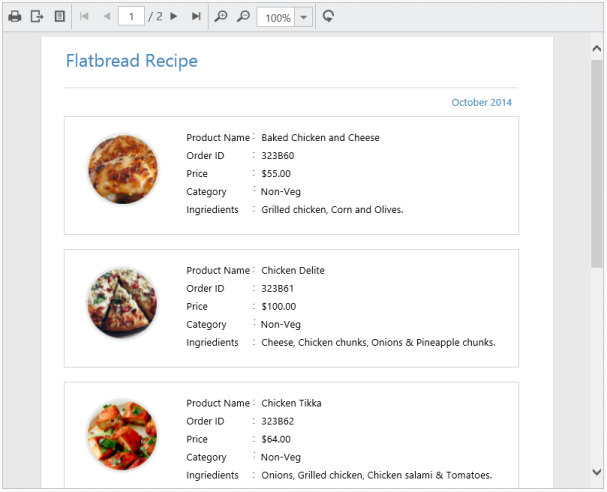
Product List RDLC Report